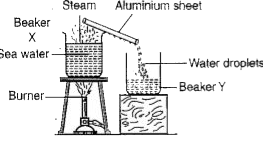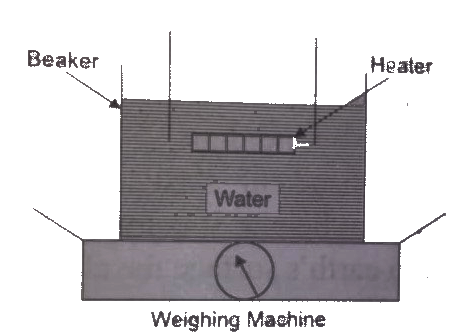Jyoti and Sanjay were doing an experiment in which water was to be heated in a beaker. Jyoti kept the beaker near the wick in the yellow part of the candle flame. Sanjay kept the beaker in the outermost part of the flame. Which water will get heated in a shorter time?
To determine which beaker of water will heat up faster, we need to analyze the positions of Jyoti's and Sanjay's beakers in relation to the candle flame.
1. Identify the Locations of the Beakers:
- Jyoti placed her beaker near the wick in the yellow part of the candle flame.
- Sanjay placed his beaker in the outermost part of the flame.
2. Understand the Characteristics of the Candle Flame:
- The candle flame consists of different zones: the inner part (near the wick), the middle part (yellow part), and the outermost part (blue part).
- The yellow part of the flame indicates incomplete combustion, which occurs due to a lack of sufficient oxygen. This results in less heat being produced.
- The outermost part of the flame is blue, indicating complete combustion, which occurs when there is sufficient oxygen available. This part of the flame produces more heat.
3. Compare the Heating Efficiency:
- Since Jyoti's beaker is in the yellow part of the flame, it will receive less heat due to incomplete combustion.
- Sanjay's beaker, on the other hand, is in the outermost part of the flame, where complete combustion occurs, resulting in a higher temperature and more heat being produced.
4. Conclusion:
- Therefore, the water in Sanjay's beaker will get heated in a shorter time compared to the water in Jyoti's beaker.
Final Answer:
The water in Sanjay's beaker will get heated in a shorter time because it is placed in the outermost part of the flame, where complete combustion occurs, producing more heat.
---
- Jyoti placed her beaker near the wick in the yellow part of the candle flame.
- Sanjay placed his beaker in the outermost part of the flame.
- The candle flame consists of different zones: the inner part (near the wick), the middle part (yellow part), and the outermost part (blue part).
- The yellow part of the flame indicates incomplete combustion, which occurs due to a lack of sufficient oxygen. This results in less heat being produced.
- The outermost part of the flame is blue, indicating complete combustion, which occurs when there is sufficient oxygen available. This part of the flame produces more heat.
- Since Jyoti's beaker is in the yellow part of the flame, it will receive less heat due to incomplete combustion.
- Sanjay's beaker, on the other hand, is in the outermost part of the flame, where complete combustion occurs, resulting in a higher temperature and more heat being produced.
- Therefore, the water in Sanjay's beaker will get heated in a shorter time compared to the water in Jyoti's beaker.
The water in Sanjay's beaker will get heated in a shorter time because it is placed in the outermost part of the flame, where complete combustion occurs, producing more heat.
Topper's Solved these Questions
- BOOK - S CHAND IIT JEE FOUNDATIONCHAPTER - COMBUSTION AND FLAME EXERCISE - Question Bank-1739videos
COMBUSTION AND FLAME
- BOOK - S CHAND IIT JEE FOUNDATIONCHAPTER - COMBUSTION AND FLAME EXERCISE - Self Assessment Sheet-17(Fill in the blanks)22videos
COMBUSTION AND FLAME
- BOOK - S CHAND IIT JEE FOUNDATIONCHAPTER - COMBUSTION AND FLAME EXERCISE - Question Bank-17(Answer true or false)6videos
COMBUSTION AND FLAME
- BOOK - S CHAND IIT JEE FOUNDATIONCHAPTER - COAL AND PETROLEUMEXERCISE - Self Assessment Sheet-1610videos
COAL AND PETROLEUM
- BOOK - S CHAND IIT JEE FOUNDATIONCHAPTER - HYDROGENEXERCISE - SELF ASSESSMENT SHEET28videos
HYDROGEN
Similar Questions
Abida and Ramesh were doing an experiment in which water was to be heated in a beaker. Abida kept the beaker near the wick in the yellow part of the candle flame. Ramesh kept the beaker in the outermost part of the flame. Whose water will get heated in a shorter time?
View SolutionAbida and Ramesh were doing an experiment in which water was to be heated in a beaker. Abida kept the beaker near the wick in the yellow part of the candle flame. Ramesh kept the beaker in the outermost part of the flame. Whose water will get heated in a shorter time?
View Solution
Knowledge Check
- Question 1 - Select One
In the given experiment, some sea water was heated in a beaker. After some time, it was observed that the number of water droplets formed on the aluminium sheet become less and less. Why was this so?

(i) The aluminium sheet had become hotter
(ii) The rate of condensation had decreased
(iii) Beaker X had become hotterA(i) and (iii) onlyB(i) and (ii) onlyC(ii) and (iii) onlyD(i),(ii) and (iii) - Question 2 - Select One
As part of an experiment to determine the latent heat of vaporisation of water, a student boils some water in a beaker using an electric heater as shown below. The student notes two sources of error.

Error-1: thermal energy is lost from the sides of the beaker
Error -2: As the water is boling water splashes out of the beaker
Which of the following gives the correct effect of these two errors on the calculated value for the specific lalent heat?AError-1 = increases , Error-2 = DecreaseBError-1 = increases , Error-2 = increaseCError-1 = Decreases , Error-2 = increaseDError-1 = Decreases , Error-2 = Decrease - Question 3 - Select One
Students were carrying out an experiment in the laboratory, in which one of the steps involved heating the alcohol. However, the teacher strictly instructed the students not to heat alcohol directly on flame. Why do you think the teacher gave such an instruction?
AThe temperature of the flame is not high enough to heat alcohol.BAlcohol is highly inflammable.CThe heat of the flame is sufficient enough to overcome the ignition temperature of alcohol and it can easily catch fire.DBoth (b) and (c)
Abida and Ramesh want to heat water taken in separate beakers . Abida kept the beaker near the wick in the yellow part of the candle flame. Ramesh kept the beaker in the outermost part of the flame . Whose water will get heated in a shorter time ? Why ?
View SolutionThe water heated by Ramesh will get heated in a shorter time because he kept his beaker near the hottest zone of the flame. Comment.
View SolutionName the process by which
water in a beaker gets heated by the burner kept below it.View SolutionA student heats a beaker containing ice and water. He measures the temperature of the content of the beaker as a function of lime. Which of the following would correctly represent the result ? Justify your choice .
 View Solution
View SolutionA student heats a beaker containing ice and water. He measures the temperature of the content of the beaker as a function of lime. Which of the following would correctly represent the result ? Justify your choice .
 View Solution
View Solution

